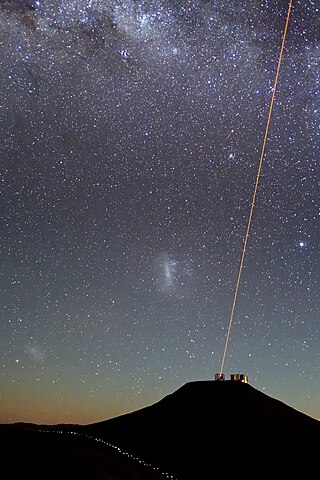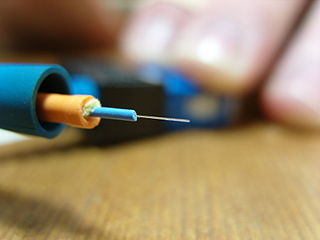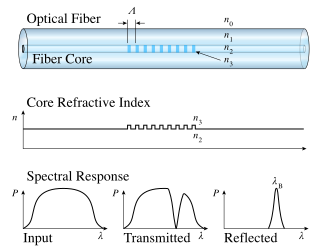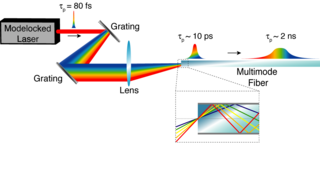Related Research Articles

A laser is a device that emits light through a process of optical amplification based on the stimulated emission of electromagnetic radiation. The term is an acronym for light amplification by stimulated emission of radiation. The first laser was built in 1960 by Theodore Maiman at Hughes Research Laboratories, based on theoretical work by Charles H. Townes and Arthur Leonard Schawlow.
In telecommunications, a cutback technique is a destructive technique for determining certain optical fiber transmission characteristics, such as attenuation and bandwidth.

An optical amplifier is a device that amplifies an optical signal directly, without the need to first convert it to an electrical signal. An optical amplifier may be thought of as a laser without an optical cavity, or one in which feedback from the cavity is suppressed. Optical amplifiers are important in optical communication and laser physics. They are used as optical repeaters in the long distance fiberoptic cables which carry much of the world's telecommunication links.
In multimode fiber optics, mandrel wrapping is a technique used to preferentially attenuate high-order mode power of a propagating optical signal. Consequently, if the fibre is propagating substantial energy in affected modes, the modal distribution will be changed.

An optical attenuator, or fiber optic attenuator, is a device used to reduce the power level of an optical signal, either in free space or in an optical fiber. The basic types of optical attenuators are fixed, step-wise variable, and continuously variable.

In fiber optics, polarization-maintaining optical fiber is a single-mode optical fiber in which linearly polarized light, if properly launched into the fiber, maintains a linear polarization during propagation, exiting the fiber in a specific linear polarization state; there is little or no cross-coupling of optical power between the two polarization modes. Such fiber is used in special applications where preserving polarization is essential.

Multi-mode optical fiber is a type of optical fiber mostly used for communication over short distances, such as within a building or on a campus. Multi-mode links can be used for data rates up to 100 Gbit/s. Multi-mode fiber has a fairly large core diameter that enables multiple light modes to be propagated and limits the maximum length of a transmission link because of modal dispersion. The standard G.651.1 defines the most widely used forms of multi-mode optical fiber.

A fiber Bragg grating (FBG) is a type of distributed Bragg reflector constructed in a short segment of optical fiber that reflects particular wavelengths of light and transmits all others. This is achieved by creating a periodic variation in the refractive index of the fiber core, which generates a wavelength-specific dielectric mirror. Hence a fiber Bragg grating can be used as an inline optical fiber to block certain wavelengths, can be used for sensing applications, or it can be used as wavelength-specific reflector.
The equilibrium mode [power] distribution of light travelling in an optical waveguide or fiber, is the distribution of light that is no longer changing with fibre length or with input modal excitation. This phenomenon requires both mode filtering and mode mixing to occur in the fibre to produce a state that is independent of the mode power distribution launched by the light source. At propagation distances exceeding the equilibrium length, intramodal pulse distortion increases as the square root of length.
An optical waveguide is a physical structure that guides electromagnetic waves in the optical spectrum. Common types of optical waveguides include optical fiber waveguides, transparent dielectric waveguides made of plastic and glass, liquid light guides, and liquid waveguides.

Double-clad fiber (DCF) is a class of optical fiber with a structure consisting of three layers of optical material instead of the usual two. The inner-most layer is called the core. It is surrounded by the inner cladding, which is surrounded by the outer cladding. The three layers are made of materials with different refractive indices.
In laser science, the parameter M2, also known as the beam propagation ratio or beam quality factor is a measure of laser beam quality. It represents the degree of variation of a beam from an ideal Gaussian beam. It is calculated from the ratio of the beam parameter product (BPP) of the beam to that of a Gaussian beam with the same wavelength. It relates the beam divergence of a laser beam to the minimum focussed spot size that can be achieved. For a single mode TEM00 (Gaussian) laser beam, M2 is exactly one. Unlike the beam parameter product, M2 is unitless and does not vary with wavelength.

Fiber-optic communication is a method of transmitting information from one place to another by sending pulses of infrared light through an optical fiber. The light is a form of carrier wave that is modulated to carry information. Fiber is preferred over electrical cabling when high bandwidth, long distance, or immunity to electromagnetic interference is required. This type of communication can transmit voice, video, and telemetry through local area networks or across long distances.

Modal analysis is the study of the dynamic properties of systems in the frequency domain. Examples would include measuring the vibration of a car's body when it is attached to a shaker, or the noise pattern in a room when excited by a loudspeaker.
Modal dispersion is a distortion mechanism occurring in multimode fibers and other waveguides, in which the signal is spread in time because the propagation velocity of the optical signal is not the same for all modes. Other names for this phenomenon include multimode distortion, multimode dispersion, modal distortion, intermodal distortion, intermodal dispersion, and intermodal delay distortion.
A distributed-feedback laser (DFB) is a type of laser diode, quantum-cascade laser or optical-fiber laser where the active region of the device contains a periodically structured element or diffraction grating. The structure builds a one-dimensional interference grating, and the grating provides optical feedback for the laser. This longitudinal diffraction grating has periodic changes in refractive index that cause reflection back into the cavity. The periodic change can be either in the real part of the refractive index or in the imaginary part. The strongest grating operates in the first order, where the periodicity is one-half wave, and the light is reflected backwards. DFB lasers tend to be much more stable than Fabry–Perot or DBR lasers and are used frequently when clean single-mode operation is needed, especially in high-speed fiber-optic telecommunications. Semiconductor DFB lasers in the lowest loss window of optical fibers at about 1.55 μm wavelength, amplified by erbium-doped fiber amplifiers (EDFAs), dominate the long-distance communication market, while DFB lasers in the lowest dispersion window at 1.3 μm are used at shorter distances.
ClearCurve is Corning's brand name for a new optical fiber that can be bent around short-radius curves without losing its signal. It is constructed with a conventional fiber on the inside, surrounded by a cladding containing a new nanostructured reflector. ClearCurve is hundreds of times more flexible than conventional optical cable, transmitting high-quality signals even when wrapped around small objects like a pen, where a conventional cable would lose the signal completely.
A superluminescent diode is an edge-emitting semiconductor light source based on superluminescence. It combines the high power and brightness of laser diodes with the low coherence of conventional light-emitting diodes. Its emission optical bandwidth, also described as full-width at half maximum, can range from 5 up to 750 nm.
A fiber-optic patch cord is a fiber-optic cable capped at either end with connectors that allow it to be rapidly and conveniently connected to CATV, an optical switch or other telecommunication equipment. Its thick layer of protection is used to connect the optical transmitter, receiver, and the terminal box. This is known as "interconnect-style cabling".

Chromo-modal dispersion (CMD) results from exciting various modes of a multimode waveguide with unique spectral components of a broadband optical signal. Modal dispersion during propagation in the waveguide then provides group velocity dispersion to the signal. The large modal dispersion inherent to multimode waveguides enables the dispersion per unit length of a chromo-modal dispersion device to be several orders of magnitude higher than that of diffraction grating or dispersion compensating fiber-based dispersive elements.
References
- 1 2 "Archived copy" (PDF). Archived from the original (PDF) on 2013-02-17. Retrieved 2012-02-08.
{{cite web}}: CS1 maint: archived copy as title (link) - ↑ United States Patent